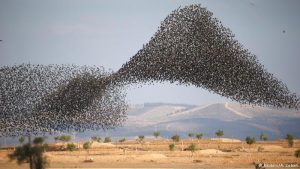 What is a murmuration?” Chances are, you’ve witnessed the startling grace and beauty of a murmuration of starlings. A murmuration is when a mass of starlings fly in a coordinated manner in what appears to be a moving black cloud. But how is it possible that these birds can be so in tune with each other to know the exact patterns that they fly in? Let’s explore.
What is a murmuration?” Chances are, you’ve witnessed the startling grace and beauty of a murmuration of starlings. A murmuration is when a mass of starlings fly in a coordinated manner in what appears to be a moving black cloud. But how is it possible that these birds can be so in tune with each other to know the exact patterns that they fly in? Let’s explore.
The starling is officially referenced as the European Starling, so named after their place of origin. Currently, the starling is well-spread around the globe with enough physical changes to create more than 10 sub-species of the bird. Typically, a common starling is about 7.5” to 9” long, weighs about 2 to 3 ounces, all with a wingspan of approximately 12” to 17”. They are a noisy bird, and hang in fairly large flocks (murmurations). In the US, the starling populatio is thought to be approximately 200 million. Their current conservation status is Least Concern, indicating that there is little risk of their extinction. They appear to be resourceful and fully adaptable.
The stand-apart beauty of these birds is in their majestic display of flying in concert as a flock. If you have seen this, then you know full well how mesmerizing it can be. Just how they are able to attain such symmetry in flight is the wonder. Fortunately, science has studied just how the starlings achieve such perfection in flight by studying video and photo shots from those videos.
The Science Behind Their Synchronicity
In 2012, a science paper published in 2012 concluded that any individual bird within the flying murmuration is perfectly in sync with only seven of its closest birds. With that, they are able to maintain a perfect flight pattern along with the entire flock. The scientist, George F. Young, evaluated photos and videos from flocks of 440 to around 2,600 in size. For any bird, if uncertainty arose as to direction, it immediately adjusted to the pattern of its closet seven pals in flight. The science is simple and demystifies the stunning vision of perfect flight.
In actuality, this is not a unique display of cohesion. In fact, if you have seen a school of fish, you would find that they exhibit the same manner of grace in swimming that the starlings produce in flight. Also, if you notice many birds of other species that are gathered in small flocks, you will see that when they fly, they have an interesting control of their combined flight patterns. It might not be as graceful as a starling murmuration (or a large school of fish), but you can see the same science at work.
Nature is full of immeasurable and uncountable art not attainable by human means. And for that, we come to love it more deeply, and to amaze at the science of it all.





